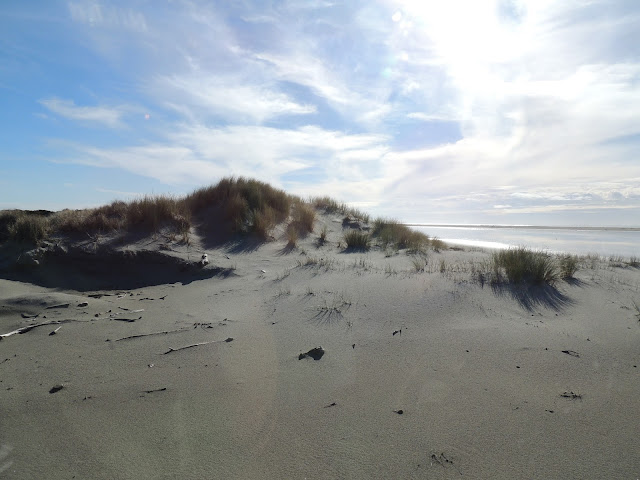On our way to the spit we stopped at Cape Farewell.
Our driver and guide Tony works for the family-owned company that for 70 years has been making this trip, initially in 1946 as a mail-and-supplies run to the lighthouse keepers. Vehicle access to this area is given only to Maritime NZ, the DOC, and a couple of tour operators. Here we're starting on the Golden Bay side of the spit, tide out to our right.
A lefthand turn takes us 1.2 km across the spit (the skinny "beak" of the kiwi-shaped peninsula) to the Tasman Sea side. I'll add a map below so you get a feel for it
Along the way, Tony shared so much information I took notes. Like how the godwit (see illustration below) flies nonstop from Alaska to NZ--12,000 km--in eight days, cruising at an altitude of 10,000 feet and arriving with half the bodyweight it carried upon departure.
We arrive at Fossil Point to wander about. It's described thusly in the literature:
Fossil Point is recognised as the base of Farewell Spit - the area where
the land drops off the high rugged sandstone cliffs that run north from
Wharariki to Puponga and down on to the flat coastal sands on the spit
itself. It's a beautiful meeting place of ocean and land where busy pied
oystercatchers strut along the surf-line and big gulls wheel on the
swirling air currents above. Look closely here and you'll see small
fossilised shells and worms outlined in the rock at the base of the
cliffs.
The scale is overwhelming. Can you see wee me below?
Art's Galileo Pro app doesn't require cell service to show location, and a good thing since there's no cell reception here. See arrow below.
Back in the bus, the kilometers unspooled as we trundled along, taking in the expanse of sand and sea.
This tree disengaged itself in the Dec 2010 Golden Bay flood, likely tumbling down all the way from the Heaphy Track, into the Aorere River, and from there to the bay, washing up here, where it's been firmly ensconced ever since.
In 1642 explorer Abel Tasman described Farewell Spit as a "duney hook." It's believed there was much more vegetation here--trees included--back when Maori burned forests to flush out giant moa. Europeans brought cattle and sheep to the land.
We finally reach the lighthouse.
Construction started on the first lighthouse back in 1869, but as it was
constructed of wood it deteriorated quickly in the abrasive sand-laden
winds that roar across this exposed site. A new steel lighthouse was
built in the 1890s and is still operating today, although now on mains
power with an automated light.
The first lighthouse included three lighthouse-keeper cottages, with all materials arriving via horse-drawn sleds. This freshly painted lighthouse has more modern wind-resistant legs and still includes elements from the late-1800s structure.
Location check.
The lighthouse had three keepers until 1954 and two until 1976, when 27 km worth of cable was laid down the middle of the spit to power the bulbs. From kerosene and diesel to electricity.
Original lighthouse lens, made in France of course. The original lighthouse was constructed 5 km before the end of the spit because the last 5 k is underwater at high tide.
Each of the three former keeper cottages is assigned to DOC, Maritime NZ, or the tour groups. The houses are very sweet. I'd volunteer to be a lighthouse keeper if they needed one (wait--can I get netflix out here?).
Maori carving at the lighthouse
Pakeha=Europeans
Tony served coffee and tea plus muffins made at the Collingwood Tavern and soon, ever tide-aware, we were back on the sandy path to the beach.
A few more exploratory stops left us breathless with the vastness and the day itself.
This pristine finger of sand--600 feet deep before the rock that undergirds it--is a vital part of the lifecycle of countless species. It's so good to see it protected.



































This comment has been removed by a blog administrator.
ReplyDelete